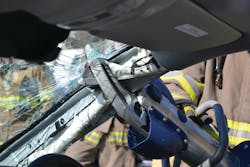SUBJECT: Airbags
TOPIC: Airbag Cutting
OBJECTIVE: Understanding of areas of an airbag system that can be cut and areas that cannot be cut during extrication activities
TASK: The rescue team shall be able to identify areas of a roof-mounted airbag system that can be cut into or through during an extrication incident
In this University of Extrication column, we focus on the challenges of performing typical extrication tasks when a roof-mounted airbag system is present. Rescue personnel must understand what components of the system can be cut into and what portions have to be avoided when accomplishing roof removal tasks. For the safety of operating personnel as well as the patients we are working to extricate, these systems must be understood, identified and worked with safely at the rescue scene.
The first step in working with a roof-mounted airbag system at a crash scene is identifying that it is present. Rescue crews should assume that at least one roof airbag is present on each side of the crash-damaged vehicle until proven otherwise. Remember that the airbag ID markers for roof-mounted airbags DO NOT indicate the location of the stored gas inflator. They simply advertise that roof airbags are present for side impacts or rollovers.
Next, rescue personnel must determine whether the airbag system is undeployed or if in fact, it has deployed. This is an easy step because a deployed roof airbag will be visible to responders as they initially approach the vehicle. The difference between an undeployed roof airbag and one that has deployed is significant for rescuers. Undeployed, the roof airbag still has its stored gas inflator or inflators holding full pressure. These pressures are typically 4,000 psi but may be up to 11,400 psi in some cases. Accidentally cutting into a pressurized stored gas inflator unit during an extrication could have disastrous results.
The scenario we are considering is one in which all or a portion of the roof must be removed to free the trapped patient. In this case, we’ll establish that roof airbags are present and that they have not deployed. The rescue team assigned to complete the roof task must strip the trim at every point where they will be cutting into either the roof rail or the pillars of the vehicle. With a tool as simple as a flat-bladed screwdriver, the interior trim pieces can be removed to expose the inside of the roof rail or roof pillar itself. A visual inspection at the point where cuts will be made will confirm whether the pillar is clear or if there is a component of the roof airbag system present.
If the trim or headliner has been stripped away at the point where a cut must be made and portions of the roof airbag system are present, the rescuer then must determine what function that component plays as the airbag functions. The cylinder-shaped stored gas inflators, which can be mounted on the roof rail or the A- or C-pillar for example, hold the pressurized gas needed to inflate the airbag. The stored gas inflator would be a “no-cut zone” component. If the roof airbag system has deployed, the stored gas inflator unit would have discharged its gas into the deployed airbag.
It is possible that one vehicle can have four separate roof airbags, each with its own stored gas inflator. Be careful and strip the trim at every point in a roof rail or roof pillar where cuts will be made.
It is possible that the rescuer may remove the trim and see a plastic or metal tube running along the pillar. Another possibility is that the folded airbag itself may be visible once the trim or portion of the headliner is removed. In this case, as long as the stored gas inflator or inflators have been located and they are not at the cut point, it would be appropriate for the rescuer to cut into or through the pillar and the airbag component. A folded airbag as well as any of its tubing does not contain any stored pressure prior to or after deployment. Only the inflator unit itself of an undeployed roof airbag would be pressurized.
Knowledge of the typical components of a roof-mounted airbag system is essential for rescue personnel to master. Knowing where to cut and not to cut makes a big difference at your extrication scene.
TASK: The rescue team shall be able to identify areas of a roof-mounted airbag system that can be cut into or through during an extrication incident.
About the Author
Ron Moore
RON MOORE, who is a Firehouse contributing editor, recently retired as a division chief with the McKinney, TX, Fire Department and now serves with Prosper, TX, Fire Rescue. He self-published the Vehicle Rescue 1-2-3 training manual and serves as the forum moderator for the extrication section of Firehouse.com . Moore can be contacted directly at [email protected].

